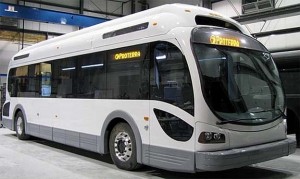General Motors is increasing its stake in a South Carolina start-up producing battery-electric buses.
The move is just the latest by GM Ventures targeting potentially lucrative opportunities that can help it develop lighter, cleaner, smarter and lower-cost vehicles – while also generating potentially significant new sources of cash if the subsidiary can match the performance of other high-risk investors.
GM Ventures is one of six venture capital firms, or VCs, pumping $23 million into Proterra, Inc., of Greenville, S.C. Among the other investors is the giant Silicon Valley VC fund Kleiner Perkins Caufield & Byers, which has joined GM in several other projects funded by GM Ventures. It’s the second round of funding for Proterra that the Detroit-based investment fund has participated in.
Protera’s EcoRide buses can travel up to 40 miles and then recharge in as little as 10 minutes, targeting a number of urban transit systems. The firm reports its list of customers has grown from two to seven over the last 18 months, and the firm will use the new investment to seek business overseas, it says. Proterra’s workforce has grown nearly six-fold, to 175, since 2010.
With an initial $100 million at its disposal, GM Ventures has announced a string of investments in recent months, all focused on potentially lucrative start-ups. They cover a wide array of companies, from a Rhode Island manufacturer of ultra-strong steels to an Israeli firm that has developed a way to let motorists wirelessly charge their cellphones while driving. The VC has backed a start-up whose technologies could make it easier to weld aluminum and another focused on solar power.
But all have connections to the transportation industry, according to 54-year-old Jon Lauckner, who serves a dual role as GM’s Chief Technology Officer and the head of GM Ventures which was formed in June 2010.
“Technology is evolving really, really rapidly in automotive today,” Lauckner, a 33-year GM veteran, said during a media briefing in San Francisco last week.
He outlined five keep areas that GM Ventures is focusing on:
- Batteries, motors and other automotive clean propulsion technologies;
- Voice recognition and other connected-vehicle technologies;
- Advanced steels, aluminums, carbon fiber and other advanced materials that can maker vehicles stronger and lighter;
- Advanced sensors, memory and processors, especially for use in autonomous driving technology; and
- Technologies that can improve manufacturing efficiency.
“These are areas where we expect significant breakthroughs and if you can get an advantage it will give you a solid leg up” on competitors such as Ford or Toyota, Lauckner emphasized.
Not surprisingly, the executive declined to discuss what new start-ups he might be eyeing for future investments but he noted that besides Silicon Valley he’s watching potential prospects in places like Germany and in Israel, where Powermat Technologies, the maker of the in-vehicle charging technology, is based.
Unlike most venture capital firms, which simply hope to get in early with their investments, nurture a firm and then sell off their stake for a big windfall, GM Ventures has a dual purpose. It also looks for start-ups that could help it improve the cars its parent builds.
Rhode Island’s NanoSteel is developing a new way to produce the time-tested metal in ways that can make it not only stronger but light enough to compete with light but far more costly aluminum or carbon fiber for producing vehicle platforms and bodies.
Of all the firms GM Ventures has invested in, none have yet reached the stage they can go public, thugh Lauckner hinted Powermat is furthest along.
“We haven’t had an exit yet,” Lauckner said, hinting that, “Hopefully we’ll get an exit in the not-to-distant future.”
Among the many areas that both GM Ventures and General Motors itself are watching closely, there’s a particular interest in electrification. During last week’s 2-day media briefing, GM’s global product development director Mary Barra said the maker expects to have about 500,000 battery-based vehicles on the road by 2017, and “Plug-based solutions will play a significant role in our technology portfolio going forward,” she emphasized.
At the upcoming LA Auto Show, GM will introduce the Chevrolet Spark EV, its first battery-electric vehicle since the EV1 was pulled from production in 1999. Meanwhile, it will add another plug-in hybrid model next year, the Cadillac ELR sharing the basic “Voltec” drive system first introduced in the Chevy Volt.
The challenge, according to Lauckner, is to find batteries that deliver “higher performance at lower cost.” But he cautioned that the industry is likely to see current lithium-ion battery technology evolve rather than experience a major revolutionary breakthrough – at least in the near-term.
Currently, he noted, makers like GM are spending about $300 to $400 per kilowatt-hour – a figure that doesn’t include the hefty, additional costs of producing a climate-controlled battery pack. Eventually, the Department of Energy expects that to drop to $125 – even as batteries get smaller, lighter and more powerful. But that’s a long-term goal, Lauckner cautioned. “Probably within the next five years,” he suggested, something in the $200 to $300 range is more likely.
Electric propulsion, he contended, is a game of slow improvements, each new generation getting a bit better than before – though he also added that, “I’d bet there’s a good chance you’ll see another (alternative) besides lithium-ion in use by 2025,” possibly something like the metal-air battery technologies still relegated to the research labs.
But 2025 is a long way off. And that is a key reason why GM Ventures is also investing in conventional gasoline technologies which, said Lauckner, “is still part of the game.”


